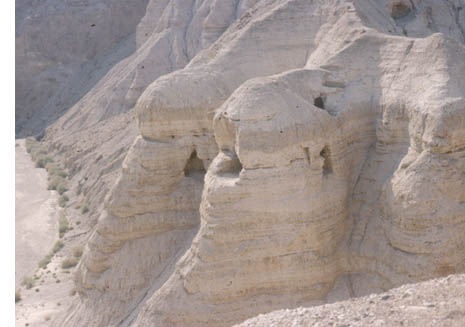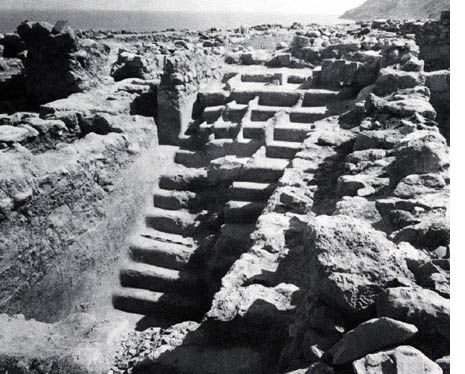Distributed October 29, 2002
For Immediate Release
News Service Contact: Mary Jo Curtis
Conference scholars to consider mysteries of Qumran Nov. 17-19
Brown’s Center for Old World Archaeology and Art will host “Qumran: The Site of the Dead Sea Scrolls” on Nov. 17-19, 2002. This is the first international conference on the Qumran community, and it will bring together some of the world’s leading archaeological scholars to consider the many unanswered questions about the settlement.
PROVIDENCE, R.I. — It was in the caves of Qumran in 1947 that two Bedouin shepherd boys discovered the Dead Sea Scrolls. While the mysteries of the scrolls have been largely resolved, numerous mysteries surrounding the settlement of Qumran remain.
A group of the world’s leading archaeological scholars will gather at Brown University Nov. 17-19, 2002, to examine those unanswered questions. The Center for Old World Archaeology and Art will host “Qumran: The Site of the Dead Sea Scrolls,” the first international conference on the settlement. A conference schedule is attached.

Qumran
In 1947, two Bedouin boys found the Dead Sea Scrolls in caves like these at Qumran. Scholars have since resolved the mysteries of the scrolls, but many questions about the ancient settlement remain unanswered. [Photo: Ecole Biblique et Archéologique Française de Jérusalem]
“Few sites in Greco-Roman Palestine still attract as much interest from scholars and the public alike as Qumran,” said archaeologist Katharina Galor, the conference organizer and a visiting assistant professor at the Center. “To date it has been the scrolls that have stood in the spotlight. Those who have tried to explain the mysteries of the site have been mostly historians, not archaeologists. Archaeological methodologies have been largely neglected.”
The conference will focus squarely on the archaeology of the site – the settlement and surrounding caves, the regional setting of the ruins, architectural features and small finds. Galor believes the work of the participating scholars will provide a fundamental base for future research. Until now, she notes, scholarly controversies and cultural and political differences have resulted in a lack of communication between the Israeli, American and European archaeologists and those from the Ecole Biblique et Archéologique Française de Jérusalem, the school that led the first major excavations of Qumran in the 1950s.
“More books and articles have been written on Qumran than on any other archaeological site in the Near East,” although many of the scholars have never met face-to-face, said Galor. “They’re coming to neutral ground here at Brown.”
Father Roland DeVaux, the Dominican priest who led the original Ecole Biblique excavation, concluded Qumran was a self-contained monastic settlement of Essenes, the strict Jewish sect that wrote the Dead Sea Scrolls. DeVaux published a preliminary report on his findings, but he died in 1971 without completing his final report.

Ritual purity
This miqveh, left, was one of the many stepped and plastered pools excavated at Qumran by Roland DeVaux, who led the original excavation from which the image comes. These installations are usually interpreted as ritual pools (miqva’ot) associated with the preoccupation of the Dead Sea Scroll sect with issues of ritual purity. [Photo: Ecole Biblique et Archéologique Française de Jérusalem]
Much of the scholarship on the scrolls and Qumran has been based on that preliminary report, according to Galor, yet some evidence contradicts the priest’s findings. Subsequent Qumran scholars have argued the building complex was inadequate for a religious community; some believe Qumran was the site of a manor house, military fort or commercial storage and distribution center. Qumran also included a cemetery, but there is no agreement on how many people were buried there or whether the dead included both males and females – a detail that could support or contradict DeVaux’s conclusions on the Essenes.
Galor will present her own research on the stepped and plastered pools unearthed by DeVaux. Delineating which of these were religious ritual pools and which were used for water storage may help determine whether Qumran could indeed have been an Essene settlement. Galor will be joined by a host of speakers from around the world, including DeVaux’s successor at the Ecole Biblique, Father Jean Baptist Humbert, who has collected DeVaux’s field notes and is about to publish a final report on his work.
“This is an excellent opportunity for the academic and non-academic communities to hear an array of leading international scholars in the field,” said Galor.
The proceedings of the conference will be published, and Galor predicts this volume will “constitute an important collection of scholarly contributions to the archaeology of Qumran – the first of its kind.”
The conference has been funded in part by grants from the National Endowment for the Humanities, the Rhode Island Committee for the Humanities, Shelby White and Leon Levy, and the Brown Faculty Lectureship Fund. It is co-sponsored by the Ecole Biblique et Archéologique Française de Jérusalem and various departments at Brown. For more information, call (401) 863-2742, visit the Web site, or e-mail [email protected]. Sessions are free and open to the public; registration is required.
Conference Schedule
Sunday November 17
1 to 2 p.m., Smith-Buonanno foyer
Registration
2 to 3 p.m., Smith-Buonanno, Room 106
Session I: Opening Session
Chair: Martha Sharp Joukowsky, director, Center for Old World Archaeology and
Art
- De Vaux’s Interpretation in Perspective
Jean-Baptiste Humbert, École Biblique et Archéologique Française de Jérusalem
3:30 to 4:30 p.m., Smith-Buonanno, Room 106
Session II: Archaeological and Textual Evidence from the Qumran Region
Chair: R. Ross Holloway, Brown University
- Qumran Without Texts, and Texts without Qumran: The Quest for Archaeological
Objectivity
James D. Tabor, University of North Carolina at Charlotte - Qumran in a Regional Context
Jürgen Zangenberg, University of Wuppertal, Germany
5 to 6 p.m., Robinson Hall Rotunda
Reception and Photo Exhibit
Monday, November 18
8 to 9 a.m., Brown Faculty Club
Morning Session I: Recent Discoveries at Qumran
Chair: Stanley Stowers, Brown University
- The 1996 Excavations at Qumran: The Context of the Ostrakon
James F. Strange, University of South Florida - Important New Findings at Qumran
Itzhak Magen and Yuval Peleg, Israel Antiquities Authority - Artificial Caves at Qumran
Hanan Eshel, Bar Ilan University, Israel
10 to 11:30 a.m., Brown Faculty Club
Morning Session II: Questions of Chronology, Context and Religious
Identity
Chair: Rolf Winkes, Brown University
- Correction of an Error in Archaeological Interpretation: The Dating of the
Qumran Cave Scroll Deposits
Gregory Doudna, University of Copenhagen, Denmark - Qumran in Period III
Joan E. Taylor, Waikato University, New Zealand/University of London, U.K. - Contextual Archaeology and the Qumran-Essene Origins
Minna Lönnqvist and Kenneth Lönnqvist, University of Helsinki, Finland
12:30 to 2 p.m., Brown Faculty Club
Afternoon Session I: Material Traces of Industrial and Ritual Uses
Chair: Saul Olyan, Brown University
- The Workshops at ‘Ein Feshkha: A New Hypothesis
Mireille Bélis, École Biblique et Archéologique Française de Jérusalem - Qumran’s Plastered Installations: Cisterns or Immersion Pools?
Katharina M. Galor, Brown University - Qumran, ‘Ein Feshkha, and the Perfume Industry of Judaea During the
Reign of Herod the Great
Yizhar Hirschfeld, Hebrew University of Jerusalem, Israel
2:30 to 4 p.m., Brown Faculty Club
Afternoon Session II: Agriculture, Anthropology and Religious Symbolism
Chair: Ross Kraemer, Brown University
- Was There Agriculture at Qumran?
Magen Broshi, Israel Museum - Generating Sacred Space at Qumran: Walls as Markers and Dividers
Joan Branham, Providence College - Married Economists: Dates and Results Based on Skeletal Remains from
Qumran
Olav Röhrer-Ertl, Ludwig-Maximilians-Universität München, Germany
Tuesday, November 19
9 to 10:30 a.m., Brown Faculty Club
Morning Session I: Analyzing Qumran Pottery
Chair: Pura Nieto Hernandez, Brown University
- Why Scroll Jars?
Jodi Magness, University of North Carolina–Chapel Hill - The Pottery of Qumran and that of the Winter Palaces at Jericho
Rachel Bar Nathan, Israel Antiquities Authority - Pantries and Communal Meals at Qumran
Stephen Pfann, University of the Holy Land, Israel
11 a.m. to 12:30 p.m., Brown Faculty Club
Morning Session II: Cemeteries at Qumran and Other Regional Sites
Chair: Michael Satlow, Brown University
- Skeletal Remains from the Cemetery at Qumran: The French Collection
Susan Guise Sheridan, University of Notre Dame - The Discovery and Excavation of the Khirbet Qazone Cemetery, and its
Significance Relative to Qumran
Konstantinos D. Politis, British Museum, U.K. - New Insights on the Cemetery of Qumran
Richard Freund, University of Hartford
2 to 3:45 p.m., Brown Faculty Club
Afternoon Session I: Archaeometric Studies
Chair: David Konstan, Brown University
- The Archaeometry of Plasters: Qumran Installations as an Example
Aryeh E. Shimron, Geological Survey of Israel - Dating Qumran by Optically Stimulated Luminescence
Richard Hoptroff and Edward J. Rhodes, University of Oxford, U.K.
Aryeh E. Shimron, Geological Survey of Israel - Neutron Activation Analysis
Jan Gunneweg, Hebrew University of Jerusalem, Israel
Concluding Remarks
Jürgen Zangenberg, University of Wuppertal, Germany
######





